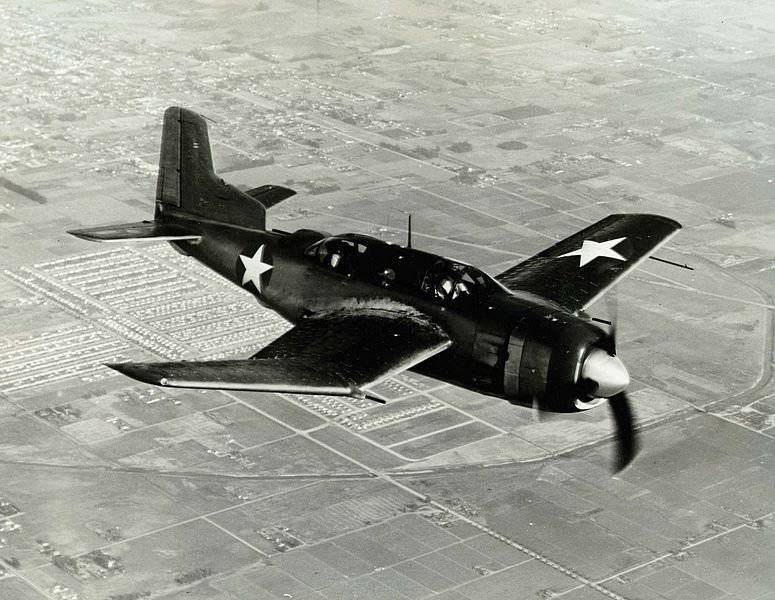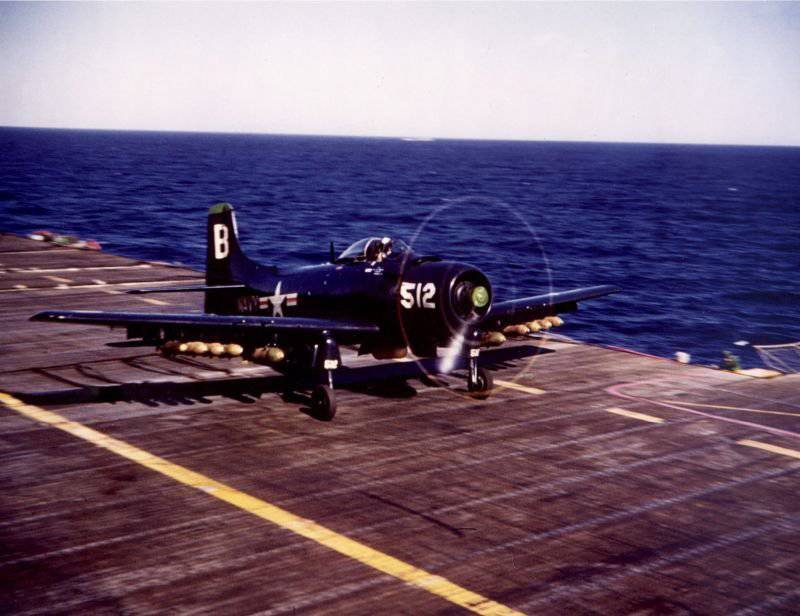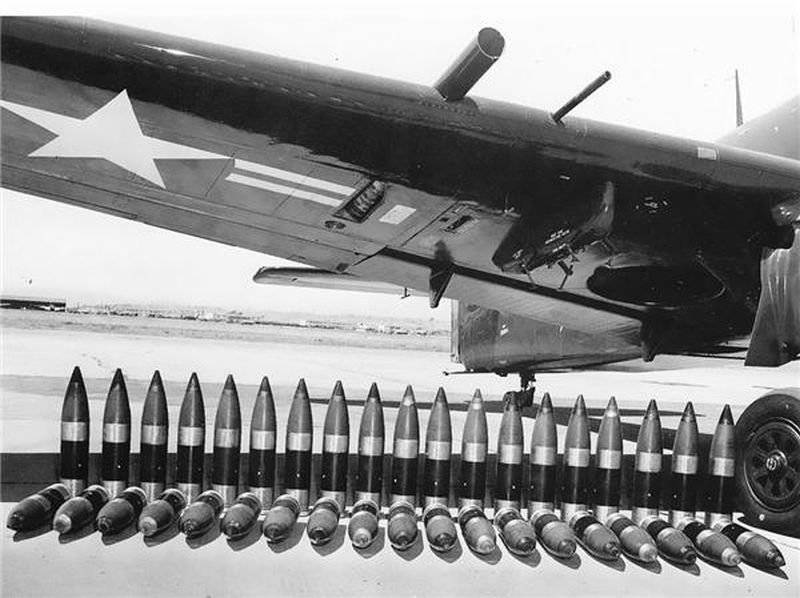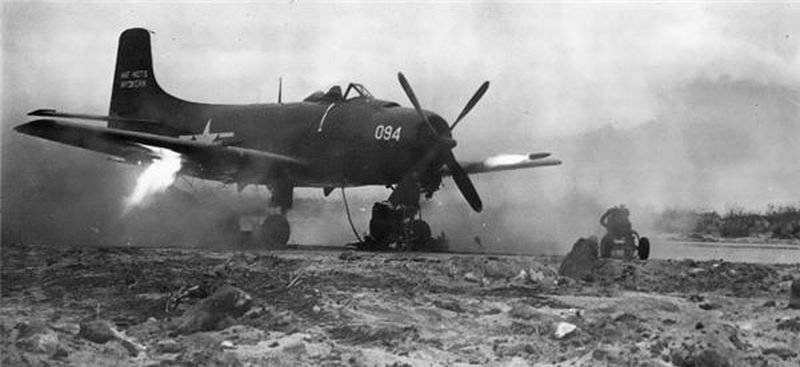In pursuit of power, the Skyraider prototype with active-jet projectiles AERO X10A.
The Skyraider aircraft is being developed at the beginning of the 40-ies to replace the outdated deck aircraft of a reconnaissance dive bomber SBD "Donfess". The Naval Department traditionally announces a competition for which the aircraft manufacturer Douglas presented an experimental model XSB2D Destroyer. On the basis of the technical specifications, the deck aircraft from the Douglas had the following characteristics:
- crew - 2 person;
- payload - 1.5 tons;
- propulsion system - 1 engine;
- chassis - 3 racks, with a nose wheel;
- armament: 5 machine guns, 2 in the wing, 3 in the mobile type turret.

In the course of testing, the United States Navy changes the terms of reference - the fleet need a torpedo bomber aircraft in a single execution. Douglas instantly responded to the new requirements and introduced the required aircraft with the new name “XBTD-1”. However, in mid-1944, the creation of Destroyer was curtailed, and the company was on the verge of losing a promising order. But the company finds strength in itself and in a short time introduced a new project of the XBT2D-1 torpedo bomber. The fleet liked the project, and he orders 15 copies of the “XBT2D-1” for testing. The competition for the creation of a deck aircraft was in full swing. In addition to Douglas, Curtiss, Martin, Boeing and Kaiser Fleetings presented their projects. To ensure victory in the competition, “Douglas” begins to fight with the “overweight” aircraft. As a result, the aircraft received the following characteristics:
- weight 5.7 tons;
- engine "Zilon-18" in 2500 hp, on prototypes stood "R3350-8" in 2300 hp;
- fuel tank 1.3 tons, with the possibility of installing an additional tank in 570 liters;
- three pylons for the suspension of torpedo-bombs, two wings and one fuselage;
- two built-in 20 mm gun in the wing;
- armored cabin;
- folding wings and retractable landing gear.
The first XBT2D-1 Dontless-II made its first flight in mid-March 1945. During the month passed factory tests. The aircraft was declared ready for transfer to the customer for testing. At the beginning of April, XBT2D-1 is transferred to the testing center of the sea. The aircraft was declared fit for production, and in May 1945, the naval department concluded a contract for the mass production of a decked torpedo bomber of almost 600 units. The end of 2МВ reduced the order of aircraft - now they needed no more than 300 units.
The company "Douglas" decided not to stop at the achieved result and began to look for other versions of the aircraft. In addition to the torpedo bomber, the following versions of the aircraft were executed:
- photo reconnaissance;
- EW aircraft;
- night bomber;
- aircraft DROiP;
At the beginning of 1946, the basic version of the aircraft receives the name "Skyraider" and the designation "AD". AD Skyraider features:
- engine "Zilon-18";
- flight speed 574 km / h;
- take-off weight up to 6.15 tons;
- range to 2.5 thousands of kilometers;
- additional armament: NURS caliber 127-mm "Holly Moses", placed on the 12-ti pylons of the wing, on which it was possible, if necessary, to hang an additional bomb load.

AD Skyraider No. 09094 with AERO X10A
Since the NURS suspension on the pylons caused a noticeable increase in vibration and resistance, the designers of Douglas decided to try to get rid of these troubles by installing the NURS in the wing design. Another reason why they worked on the installation of NURS was the growth of body armor in ground-based equipment and surface ships. Instead of the standard large-caliber guns, two launchers with tubular guides for the NURS AERO X10A, with 38 ammunition of active-jet projectiles, are installed in the wing design. The entire ammunition NURS in the number of 38 units, mass in 380 kilogram (one NURS - 10 kilogram) could be used for 6-7 seconds. All launcher - 73 kilogram.

Each launcher accounted for 19 NURS, which in a second fired approximately 3 rocket-projectile, which in flight stabilized from rotation. Gases from the launchers went through the special channels back and down. The aircraft with the "AERO X10A" passed successful tests at the marine art station in Ainikörn.

But the United States Naval Authority, in the end, did not approve this version of the aircraft. First, the customer did not want to sacrifice large-caliber guns. Secondly, in order to effectively apply the launchers, the pilots would have to approach the target at a distance of one kilometer, which did not suit either the officials or the pilots. Therefore, further work on this version of the aircraft is stopped, and by the summer of XXUMX, the project was completely closed.
Information sources:
http://alternathistory.org.ua/tankam-na-zavist-ili-127mm-pushka-na-samolete
http://www.dogswar.ru/voennaia-aviaciia/samolety/5506-shtyrmovik-ad-1-skyr.html
http://www.airwar.ru/enc/aww2/ad1.html
media = http: //www.youtube.com/watch? v = f5kNlb0prOE
Information